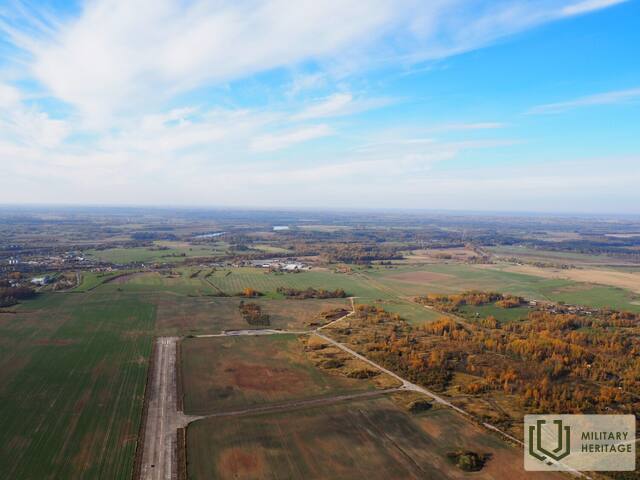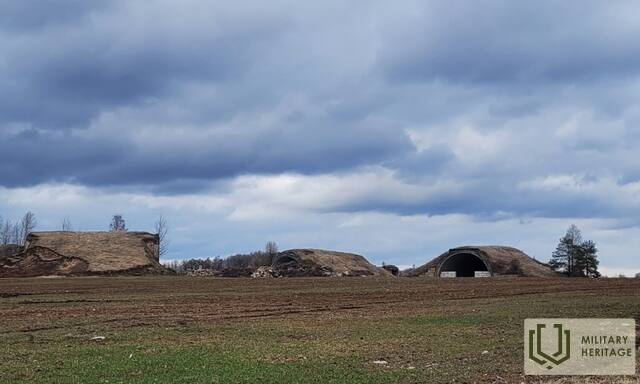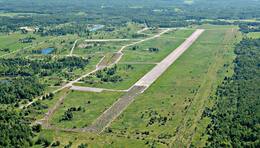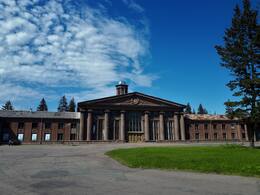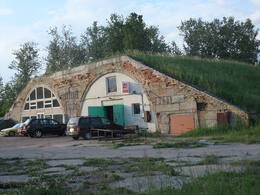Jekabpilio oro uostas
Jēkabpilio aerodromas – vienas iš karinių aerodromų Latvijos teritorijoje, kuris buvo sukurtas Nepriklausomos Latvijos laikotarpiu apie 1935 m. Po antrosios Latvijos Respublikos okupacijos 1945 m. aerodromas buvo pritaikytas SSRS karinių oro pajėgų reikmėms.
Jēkabpilio oro uostas yra maždaug 5 km atstumu nuo Jēkabpilio miesto, Jēkabpilio regione, Krustpilio valsčiuje. Aerodromo užimamas plotas yra 500 hektarų. Betoninio kilimo ir tūpimo tako ilgis siekė 2500 metrų, iš kurių išliko apie 2000 metrų ilgio ir 40 metrų pločio. Teritorijoje yra daugiau nei dešimt mažų angarų ir 7 ar 8 dideli, kurie buvo skirti didesniems lėktuvams. Taip pat yra 6 ar 7 nedideli bunkeriai – pusapvaliai betoniniai angarai, įkasti į žemę – maždaug 4 m skersmens. Jie greičiausiai buvo naudojami kaip ryšių centrai, nes buvo išdėstyti strategiškai svarbiose aerodromo vietose. Taip pat yra vienas didesnis bunkeris, kuris tikriausiai buvo naudojamas kaip pagrindinis ryšių mazgas. Buvę aerodromo infrastruktūros pastatai buvo apiplėšti ir sunaikinti. Aerodrome išliko orlaivių remonto angaras, įspūdingas statinys, nors šiuo metu tarnauja kaip drožlių saugykla, kaip ir nemažai kitų angarų. Aerodromo teritorijoje yra keletas pasagos formos pylimų. Iki Latvijos Respublikos okupacijos aerodromas veikė kaip Latvijos aviacijos pulko Krustpils aerodromas. Apie 1935 metus buvo pastatytas naujas gelžbetoninis angaras ir dviaukštės kareivinės. Iki 1939 m. buvo planuota atidaryti valstybinę oro liniją Ryga-Krustpilis-Daugpilis, tačiau tai nebuvo įgyvendinta. 1940 m. okupavus Latviją, iš Rygos Rumbulos aerodromo į aerodromą buvo perdislokuoti Latvijos aviacijos pulko naikintuvai „Gladiatorius“. Antrojo pasaulinio karo metais Liuftvafės 1-ojo laivyno (Luftflotte 1) bombonešiai buvo bazuojami Jēkabpilio aerodrome. Nuo 1962 m. Šaltojo karo metais Jēkabpilio aerodromas buvo naudojamas kaip vienas iš karinių aerodromų prie SSRS šiaurės vakarų sienos. Iki 1992 m. Jėkabpilio aerodrome buvo įkurtas Sovietų oro pajėgų 886-asis specialusis žvalgybos aviacijos pulkas (886-й Stalingrado Raudonosios vėliavos atskiras žvalgybos aviacijos pulkas, 886-й ОРАП) su dviem aviacijos eskadrilėmis, kurios naudojo Y. (Як 27Р), Mig-15 (МиГ-15), vėliau Jak-28PP (Як-28ПП), galiausiai Su 17M4R (Су-17М4Р) ir Su-24MR (Су-24МР) naikintuvai. Atkūrus Latvijos nepriklausomybę ir išvedus Rusijos kariuomenę, 547,8 hektaro ploto Jēkabpilio aerodromas atiteko Latvijos Respublikos gynybos ministerijai, kuri be jokių įsipareigojimų perdavė jį Jēkabpilio rajono tarybos nuosavybėn. 1993–1999 m. UAB "Jēkabpils oro uostas" veikė 2018 metais. 2000 metais oro uosto žemė buvo įtraukta į valstybės laisvos žemės fondą. Pastatus ir komunikacijas, įskaitant amunicijos sandėlius, komandų postus, techninius ir ūkinius pastatus, privatizavo SIA „Reka“, išskyrus 500 kilimo ir tūpimo tako plokščių, kurios buvo išdalintos rajonų savivaldybėms. Apie 2008 metus aerodromo teritorijoje buvo pastatyta asfaltbetonio gamykla, o kareivinių pastatuose veikia medžio apdirbimo įmonė. 2013 metais išliko 7 ar 8 dideli, nugriauti karinių lėktuvų angarai, o mažesnių – daugiau nei dešimt.
„MyAirfields“ duomenimis, aktyvistai pradėjo aerodromo atnaujinimo darbus – vakariniame gale pagerino dangą, nudažė navigacinį taką, įrengė kojines nuo vėjo ir kt.
• 1986 m. kovo 27 d. 886-asis SSRS karinių oro pajėgų ORAP lėktuvas Su-17M4 priartėjo prie Jēkabpilio oro bazės. Artėjant artėjimui pilotas prarado erdvinę orientaciją ir lėktuvas rėžėsi į žemę. Pilotas mirė.
https://diggers.lv/v3/jekabpils-lidlauks/
Susijusi laiko juosta
Susijusios vietos
Vaiņode air base
Vaiņode airfield still has 16 Soviet-era aircraft hangars and an 1800 m section of the once 2500 m long runway. The airfield can only be visited with a previous booking. Vaiņode airfield was established during the Latvian independence as one of the cradles of Latvian aviation and was later one of the largest military airfields in the Baltic States. In 1916, two hangars for German Army airships were built. Airships were used to gather intelligence and bomb the positions of the Russian Army. Later the city of Riga bought the airship hangars and used their roof structures to build the pavilions of the Riga Central Market. In May 1940, the 31st Fast Bomber Aviation Regiment of the Red Army moved to Vaiņode, and the construction of a standardized concrete slab runway began. At the end of the summer of 1944 the partially completed airfield was used by various German aviation units, however, at the end of World War II, the same airfield was used by the Red Army aviation units fighting the German Army group called ‘Kurzeme’. After World War II the Soviet Air Forces were stationed in Vaiņode until 1992.
Pagalvės oro uostas
Įsikūręs Rygoje, Pārdaugavoje, Spilvės pievose netoli Iļģuciems.
Spilvė karinio paveldo istorijoje garsėja ambicingu Spilvės mūšiu XVIII a. ir Spilvės aerodromas. Nuo XX amžiaus jis buvo naudojamas orlaivių bandymams, o Pirmojo pasaulinio karo metais tapo Latvijos aviacijos istorijos liudininku.
Pirmojo pasaulinio karo metais Spilvės pievas naudojo Rusijos kariuomenės oro pajėgos kovoje su vokiečių kariuomene. Sukūrus Latviją, aerodromas tapo svarbiausia šalies oro pajėgų baze ir pilotų poligonu. Ankstesni oro uosto pavadinimai buvo „Spilvės oro uostas“ arba „Rygos oro uostas“, vėliau „Rygos centrinis oro uostas“. Tai buvo pagrindinis oro uostas Latvijoje iki Rygos oro uosto atidarymo 1975 m.
Galbūt prie įspūdingų ne vieno Latvijos piloto pasiekimų prisidėjo prie Rygos esantis Spilvės aerodromas ir svajonė pasiekti žvaigždes. Galbūt, tačiau Latvijos aviacijos užuomazga gerokai senesnė ir ją galima rasti Priekulėje, kur latvių kalvis Zviedris savadarbiu aparatu išskrido iš bažnyčios bokšto.
Šiandien Spilvės oro uostas veikia. Galima pamatyti 1954 metais pastatytą oro uosto pastatą, kuris įkūnija sovietinį klasicizmą arba „Stalino imperijos“ stilių.
Šaltiniai:
Irbītis, K. Latvijos aviacija ir jos pradininkai. Ryga: Mokslas, 2004.
Brūvelis, E. Latvijos aviacijos istorija: 1919-1940. Ryga: Mokslas, 2003.
Oficiali valstybinės agentūros „Civilinės aviacijos agentūra“ svetainė. Prieiga: https://www.caa.gov.lv/lv/latvijas-aviacijas-vesture-isuma [žiūrėta 2021 02 22].
Rumbula Air Base
It is located in the southeast of Riga, in Rumbula, between Maskavas Street and the Daugava River.
In Rumbula there was an air base of the Soviet Army Air Force and a civilian airport next to Riga's main airport in Spilvė. Both airports existed until the opening of the "Riga" airport. Before the Second World War and the occupation of Latvia, the airfield of the Aviation Regiment of the Latvian Army was located in Rumbula.
After World War 2, the Soviet Union began producing jet-powered aircraft, which required longer and smoother runways. Old airfields were expanded and new airfields were built. The changeable weather conditions of the Baltic and the short flight time of the first jet planes were the reason to build many reserve airfields. The noise of the jet planes caused dissatisfaction among the residents of Riga, because the military airfield was too close to residential areas and could create dangerous situations. In 1973, it was closed and the Lielvārde airfield was built in its place, to which fighter planes were transferred. Shortly before the closure, there was an international scandal. A US Air Force officer who was one of the military attachés in Moscow was beaten there. He was allegedly attacked by 14 - 20 airport employees, who suspected that the airport was being photographed.
Today, you can see the abandoned airfield area.




